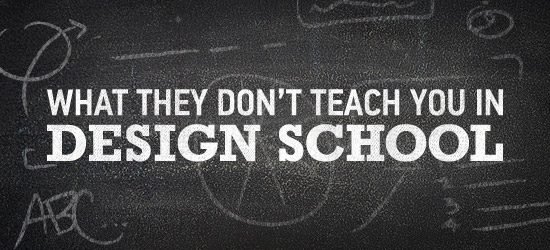Not sure what accessibility changes will have the most benefit to your existing software? Are you in the build process and need to make sure accessibility has been appropriately considered? Use this checklist as a starting point.
What They Don’t Teach You in Design School
BusinessFormal design education is great. You learn all about design fundamentals, like contrast and balance and white space and so forth. You learn about design history & heroes like Paul Rand. You learn about color theory; you learn the tools of the trade. Plus, you touch on some intangibles like time management (both how to be bad at it and how to be good at it) and working with groups. Yes, formal design education is a great thing.

Then, you get your first job and realize you have virtually no idea what’s going on – because all of a sudden you’re in a business, not a school. Uh-oh. Thus begins the real learning – what you didn’t learn in design school, and what you need to know to be a successful designer in the real world. Hit the jump to let the learning begin!
Communication
Man, do I ever harp on communication skills; but in my eyes, it’s the designer’s most important skill. In design school, you’re used to dealing with your teacher, who is formally trained (hopefully) to give clear, concise and constructive feedback. In the professional setting, all of a sudden you’re dealing with clients – some of whom are clear communicators, but many of whom are not.
So what do you have to learn? You have to learn to read between the lines: when a client says “Make the logo bigger”, chances are their issue is that their brand presence isn’t strong enough. You also have to learn to be a clear communicator yourself; you have to explain your design choices thoroughly and in common language, not design jargon.
Basic Business Practices
In design school, your jobs are to a) listen, b) learn, c) complete work, and d) repeat. In business, I’d always recommend listening, learning, and completing your work. However, either immediately or down the road, you’re going to have to learn some of the basics of business, including quoting, invoicing, filling out expense reports, and so on.
So how do learn this? Well, to be blunt, ask. Ask your boss/supervisor what you’re expected to do when it comes to completing a project from start to finish. Don’t be ashamed that you don’t know how invoicing works. Don’t be ashamed that you don’t know what to include on your quotes. Hell, these things change from business to business. Ask, learn, and try it yourself next time.
If you jump right into starting your own design business, I’d suggest either spending some time researching business practices online, or perhaps looking online for a book on the subject.
Who is Your Boss?
The best part of school projects are that, by and large, you’re the boss. Many, sometimes all, projects are fictional and designed to your exacting standards and specifications (and to your teachers’ too, I suppose). But once in the real world, that all changes.
Who is your boss in the business-driven real world of graphic design? If you’re working for a design firm, chances are your boss is either the senior graphic designer, the creative director or the head honcho of the whole operation. That much is obvious, and to some extent you need to design to please them. However, they answer to one boss – the same boss that freelance designers answer to: the client.
The client pays the bills; thus, the client calls the shots. The client is the boss. I’m not being defeatist here. I’m not saying you should just say “Sounds good, boss” if the client wants to add a photo of their cute, cuddly, psychic Bull Mastiff to the fine jewellery marketing materials. State your case as the design professional – be a clear communicator – and remember that, if it comes to it, no longer working with that client in the future is an option (albeit a last resort). Within reason, however, what the client wants, the client gets.
The sooner you recognize this and learn to let go of your projects – they’re not your babies anymore, like they may have been in school – the more satisfying your career will be. After all, it’s not art, it’s business.
Up-to-Date Design Practices
Finally, always be questioning, learning and progressing. A somewhat sad but true fact is this: what you learned in school might not be the industry standard practice by the time you land your first job. Graphic and web design are fields that are quick-movers – I mean, it seems like just yesterday that tables were an acceptable way to lay out a site. Now we have HTML5 and CSS3 working their way into the industry.
Complacency is visible everywhere in the design industry: web design businesses that still build sites using inline styling and tables, for example. Don’t be that designer. Love your field, learn from your peers, and design will give back to you. Use your schooling as a starting point to your learning, not the end point.
The point of this article is not to be down on formal design training – I think it’s great. I just think it’s beneficial to realize that schooling gives you a solid footing; it doesn’t make you Pentagram‘s creative director. There are things that can only be learned in the real world, and the sooner that is accepted and tackled with vigor, the better.
What were your memories of your first job? What struck you as odd? What made you feel like you had a lot to learn?
